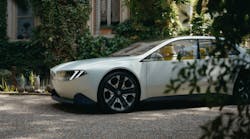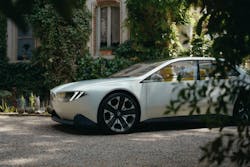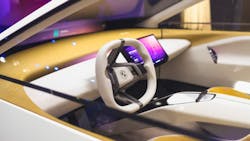Total Rebuild: BMW Reveals “New Class” of EVs
What you'll learn:
- Improvements in speed, range, etc. made for the Vision Neue Klasse.
- Details on BMW's hydrogen-powered sports activity vehicle.
For the BMW Group, IAA Mobility in Munich represented a chance to audition its all-electric Vision Neue Klasse (New Class)—the forthcoming generation of models from BMW—along with its latest sports activity vehicle featuring a hydrogen-powered fuel-cell drive system.
Boasting 30% more range, 30% faster charging, and 25% more efficiency, the Neue Klasse represents a technological leap for BMW. The same applies to its design, which “could not be any more futuristic,” said Frank Weber, member of the Board of Management of BMW AG responsible for Development. “With the Neue Klasse, we have embarked on the biggest investment in the company’s history. We are not just writing the next chapter of BMW; we’re writing a whole new book. That’s why the Neue Klasse will certainly impact all model generations.”
BMW Group CEO Oliver Zipse went even further, “The Neue Klasse means nothing less than the future of the BMW brand.”
Taken together with improvements in aerodynamics, better thermal management and higher-efficiency electric motors, BMW claims the range of its Vision Neue Klasse can be up to 30% more than the company's current EV drivetrain.
Upgrades in Power, Density, and Speed
In addition to efficient electric motors, advances in the new BMW eDrive technology include new round battery cells, with more than 20% higher energy density than that of the previously used prismatic cells. The sixth generation of BMW eDrive technology will also improve the charging speed for Neue Klasse models by up to 30%.
The vehicles feature an 800-V system for higher-speed charging, and the high-voltage battery is more than 20% denser, again according to BMW engineers. Furthermore, it’s said to reduce energy loss by up to 40%. Thanks to these measures, overall vehicle efficiency will increase by up to 25%.
The automaker also claims winter testing shows the new powertrain makes vehicles 40% more efficient in winter conditions, weighs 25% less, and costs 20% less. The BMW Group has already awarded contracts in the two-digit billion-euro range for production of the new BMW battery cells.
No Door Handles
The concept has cameras for side mirrors and there are no door handles—the doors open by means of sensors. The glass roof extends the length of the vehicle. To keep the Neue Klasse as environmentally pure as possible, it forgoes chrome, as the chrome-plating process uses toxic, carcinogen compounds. Similarly, parts on the car are unpainted, eliminating another source of pollution.
Analog operating controls have been minimized in the BMW Vision Neue Klasse—most of the controls are handled by the vehicle’s touchscreen. Human-car interaction takes place through BMW Panoramic Vision, which is what BMW calls its head-up display, and represents the BMW driving approach of "eyes on the road, hands on the wheel," along with the central display and multifunction buttons on the steering wheel.
It all starts in 2025 at a new plant in Debrecen, Hungary. The company also says its production facilities won't use any fossil fuels. Rather, it will focus on using a greater amount of recycled materials in the manufacturing process.
In time, Neue Klasse vehicles will be assembled globally, including at the Spartanburg plant in South Carolina. The Debrecen plant will be followed in 2026 by production in Munich and Shenyang, China. San Luis Potosi in Mexico will make sedans and SUVs in 2027.
The BMW iX5 Hydrogen
An ongoing topic in the automobile business is whether hydrogen can be a viable energy source for current and future vehicles. BMW is carrying out work in this field with its development and practical testing of a sports activity vehicle (SAV) with a hydrogen-powered fuel-cell drive system.
The BMW iX5 Hydrogen unveiled at IAA Mobility 2023 provided further evidence of the company’s efforts in this area of drive technology. A pilot series of the SAV with hydrogen fuel-cell drive, based on the current BMW X5, has entered service for demonstration and test purposes with various target groups around the world. This enables selected test groups who haven’t been involved in the development process to get behind the wheel of the BMW iX5 Hydrogen and gain a direct impression of its attributes for the first time.
The BMW iX5 Hydrogen is equipped with the latest, fifth-generation of BMW eDrive technology. The drive unit at the rear axle draws its energy from a high-performance battery with lithium-ion technology. It was specially developed for the hydrogen fuel-cell vehicle and generates a maximum output of 295 kW/401 hp. The electric motor also doubles as a generator that feeds energy back into the battery under braking.
The model’s two 700-bar tanks made from carbon-fiber-reinforced plastic (CFRP) together hold six kilograms of gaseous hydrogen and can be refilled in three to four minutes. A chemical reaction takes place in the fuel-cell system between the hydrogen and oxygen from the air, which generates electric power for the electric motor.
The BMW iX5 Hydrogen achieves a range of 504 km (313 miles) in the WLTP cycle without having to refill the tanks. The hydrogen-powered SAV completes the 0 to 100 km/h (62 mph) sprint in under six seconds and reaches a top speed in excess of 180 km/h (112 mph).



